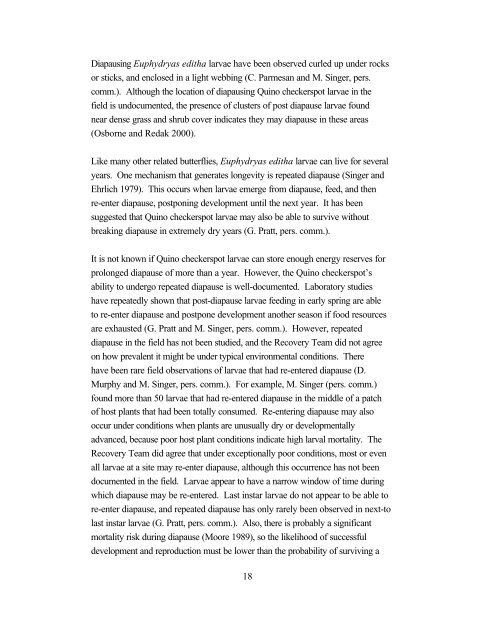Outline of Quino Recovery Plan - The Xerces Society
Outline of Quino Recovery Plan - The Xerces Society
Outline of Quino Recovery Plan - The Xerces Society
Create successful ePaper yourself
Turn your PDF publications into a flip-book with our unique Google optimized e-Paper software.
Diapausing Euphydryas editha larvae have been observed curled up under rocks<br />
or sticks, and enclosed in a light webbing (C. Parmesan and M. Singer, pers.<br />
comm.). Although the location <strong>of</strong> diapausing <strong>Quino</strong> checkerspot larvae in the<br />
field is undocumented, the presence <strong>of</strong> clusters <strong>of</strong> post diapause larvae found<br />
near dense grass and shrub cover indicates they may diapause in these areas<br />
(Osborne and Redak 2000).<br />
Like many other related butterflies, Euphydryas editha larvae can live for several<br />
years. One mechanism that generates longevity is repeated diapause (Singer and<br />
Ehrlich 1979). This occurs when larvae emerge from diapause, feed, and then<br />
re-enter diapause, postponing development until the next year. It has been<br />
suggested that <strong>Quino</strong> checkerspot larvae may also be able to survive without<br />
breaking diapause in extremely dry years (G. Pratt, pers. comm.).<br />
It is not known if <strong>Quino</strong> checkerspot larvae can store enough energy reserves for<br />
prolonged diapause <strong>of</strong> more than a year. However, the <strong>Quino</strong> checkerspot’s<br />
ability to undergo repeated diapause is well-documented. Laboratory studies<br />
have repeatedly shown that post-diapause larvae feeding in early spring are able<br />
to re-enter diapause and postpone development another season if food resources<br />
are exhausted (G. Pratt and M. Singer, pers. comm.). However, repeated<br />
diapause in the field has not been studied, and the <strong>Recovery</strong> Team did not agree<br />
on how prevalent it might be under typical environmental conditions. <strong>The</strong>re<br />
have been rare field observations <strong>of</strong> larvae that had re-entered diapause (D.<br />
Murphy and M. Singer, pers. comm.). For example, M. Singer (pers. comm.)<br />
found more than 50 larvae that had re-entered diapause in the middle <strong>of</strong> a patch<br />
<strong>of</strong> host plants that had been totally consumed. Re-entering diapause may also<br />
occur under conditions when plants are unusually dry or developmentally<br />
advanced, because poor host plant conditions indicate high larval mortality. <strong>The</strong><br />
<strong>Recovery</strong> Team did agree that under exceptionally poor conditions, most or even<br />
all larvae at a site may re-enter diapause, although this occurrence has not been<br />
documented in the field. Larvae appear to have a narrow window <strong>of</strong> time during<br />
which diapause may be re-entered. Last instar larvae do not appear to be able to<br />
re-enter diapause, and repeated diapause has only rarely been observed in next-to<br />
last instar larvae (G. Pratt, pers. comm.). Also, there is probably a significant<br />
mortality risk during diapause (Moore 1989), so the likelihood <strong>of</strong> successful<br />
development and reproduction must be lower than the probability <strong>of</strong> surviving a<br />
18
















